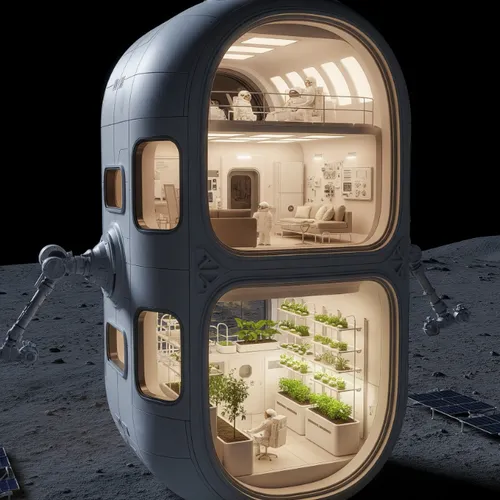Lunar Smart Adaptive Habitat Design with AI Psychological Monitoring for Crew Adaptive Positive Mental Health
Requested by NASA HH&P
Sponsored by TBD (Hospitals, Building Pharmaceutical Companies, System Companies, etc. BIO Medical, Software )
Executive Summary
This proposal presents a next-generation lunar habitat concept that merges NASA’s latest architectural and operational requirements with advanced artificial intelligence (AI) for real-time psychological health monitoring and adaptive crew support. The project is developed for the NASA HUNCH program, empowering high school students to innovate at the intersection of software, biomedical engineering, and space architecture.
Key Objectives and Innovations
Two-Phase Habitat System:
The design features a robust, modular “pill” habitat capable of supporting 2–4 astronauts, with the ability to operate autonomously for up to two years during uncrewed periods. The structure combines a rigid metallic base with an inflatable upper deck, maximizing both durability and deployable volume.
AI-Driven Personalization and Health Monitoring:
The habitat integrates state-of-the-art AI systems that continuously monitor crew psychological health using natural language processing (NLP), biometric data, and environmental sensors. These systems adapt lighting, sound, and environmental cues to individual circadian rhythms and mood, and provide virtual companions and real-time feedback to support mental well-being.
Smart Building Systems:
Advanced environmental control and life support systems (ECLSS), waste management, and power (solar arrays with nuclear backup) are managed via a smart dashboard. Automated maintenance is enabled by sensor networks, predictive analytics, and robotic systems capable of inspection, repair, and 3D printing of spare parts.
Psychological Health Methodology:
AI models—including fine-tuned large language models and task-specific classifiers—are trained on reputable datasets and astronaut data to detect depression, anxiety, and stress. Sensitivity analysis ensures robustness, and the system generates both individual and aggregate health reports for mission planners.
Human-Centered, Modular Design:
The internal layout is optimized using AI-powered generative design tools, ensuring functional zoning (crew quarters, galley, hygiene, workstations, medical, storage, ECLSS, airlock) and adjacency priorities that enhance workflow, privacy, and dust mitigation. The design is scalable and allows for future expansion.
Project Deliverables
Building Designed to host (See Specs.)
Software Prototype:
- An AI psychological monitoring dashboard and adaptive intervention system.
- Physical or Model
- Smart House Design
- A scale model demonstrating adaptive features and psychological support systems.
Strategic Impact
This proposal sets a new standard for lunar habitats by integrating operational resilience with proactive mental health support. The use of AI ensures early detection of psychological issues, personalized interventions, and efficient resource management, critical for the success of long-duration lunar missions. The approach is validated through rigorous model testing, digital twin simulations, and alignment with NASA’s Artemis-era guidelines.
Conclusion
By fusing advanced AI, modular habitat design, and a focus on astronaut well-being, this project delivers a comprehensive, future-ready solution for lunar exploration. It not only addresses the physical and psychological demands of space missions but also provides a scalable platform for ongoing innovation and student engagement in real-world NASA challenges.
This executive overview is designed to provide decision-makers and stakeholders with a concise yet comprehensive understanding of the proposal’s vision, technical approach, and strategic value.

